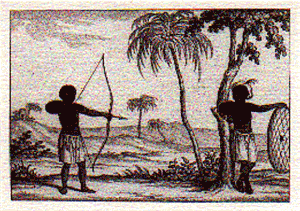UPSTAIRS,
DOWNSTAIRS
Text
and photos by Ruvan Wijesooriya
DEEP
IN EAST CHINATOWN, boys as pretty as girls keep the misfits company as
cigarette smoke lifts and chatter persists outside 47 Monroe Street, home
to the Oliver Helden showroom. Walking up the stairs, past the Chinese
brothel on the first floor and the grow-room on the second, past the hubbub
of blow dryers, makeup artists, ashen-faced models and scurrying assistants
buzzing about minor fashion emergencies, lands you in the textiled fantasy
of Oliver Helden's squatter runway show. This is the other side of the
spectrum, light years away from the champagne-doused shows of the Bryant
Park Tents, where the likes of Donna K, Bill B and Michael K hold court
year after year.
It
has been said – and proven – that anyone can be a designer at Bryant Park
if they have the money. After some mild haggling, international marketing
giant IMG charges $30,000 for use of a tent for a few hours. That, combined
with production, marketing and labor costs, adds up to nearly $100,000.
"We put our show together for around a grand," Helden says, chuckling under
his breath.
Helden
created the collection, inspired by British '70s glam and punk rock, during
breaks from his day-job as a designer at Marc Jacobs. Without a conglomerate
parent footing the bill, Helden faced the challenges of putting together
a DIY fashion show: no budget, renegade style.
"With
a little arm twisting I was able to get everyone to work on the show for
free and in trade for clothes," says Helden. "Fortunately, a handful of
extremely talented people like the clothes and ideas, otherwise pulling
off this show would have been impossible." Apart from a few professional
models willing to work for clothes and exposure, the majority were random
friends and people cast off the street. The production team consisted of
an event producer, stylist, DJ, architect and a make-up team from MAC Cosmetics,
all top-notch talent. The invites were all screenprinted by hand, the pro
sound system was lent to them for the show. "Other than postage, the only
thing we paid full price for were the daylight-balanced lights. We just
couldn't fudge on that one and have the photos and documentation end up
looking, um ... cheap," laughs Helden.
"After
scouting locations for the show and every venue being a minimum of $1000
for the day plus hundreds extra for insurance, the mindset of squatting
became even more appealing and almost romantic," he continues. Helden grew
up listening to bad music for bad people and adopted the rebel ethos early
on, so the building's sketchy history as a crackhouse was just right for
his punk rock–inspired show. "It was rented to a guy who moved in during
the summer, but stopped showing up in October when he found out that the
space didn't have any heat. He stopped paying rent, too, and just had a
mattress – hardly anything in there, really. So even though he left some
of his stuff there, I felt it was a pretty safe bet that he was never coming
back. It was a kind of shady decision but it felt appropriate for the collection,
being that it had been uninhabited for three months and the place was accessible
via the fire escape."
Twenty-four
hours before the show, the guy resurfaced. With invitations printed and
delivered, Helden and company began to freak out. "We could hear him walking
around upstairs," says Helden. He went upstairs to talk to the unwelcome
neighbor, and asked if he could rent the space the next day. "I talked
to him through the door because he wouldn't open it for me," says Helden.
"He seemed okay with the idea of us renting the space and gave me his cell
number, telling me to call him the next morning and he'd let us in. I heard
him go out that night but he didn't come back. The next morning I called
him and he didn't answer. I left messages for him every fifteen minutes
or so and he never returned my calls." By the afternoon, the production
staff couldn't wait any longer. "We ended up breaking in just like we originally
planned. We built some temporary walls with drywall and some backdrops
with huge rolls of paper. An hour before the show started I told the two
people working the door that if the upstairs guy came back, to tell him
that he wasn't on the guest list and not to let him in."
By
this time, the crowd of editors, buyers, hipsters and stylists was growing
rapidly. The sound system was blaring Bowie and Adam Ant, chairs were set
up and the lights were on full force. Nearly 180 people crammed into the
hallway, their heads bobbing as they tried to catch a glimpse of Helden's
creations. Amazingly, the show popped off without a hitch and a few hours
later, everything was moved out of the apartment, leaving no trace of the
day's debacle. "By 9:30, the space looked like nothing ever happened. I
was still in my studio at 3 a.m. when I heard him come back that night,"
says Helden.
The
next day, the show was deemed a success. Despite its distance from the
other Fashion Week activities, the turnout was spectacular, replete with
familiar faces from New York's downtown fashion scene. In the afternoon,
Helden's girlfriend/partner, Susan, saw the "upstairs guy" in the stairwell.
He looked at her and asked, "Hey, did you guys ever have your fashion show?"
When she said yes, he replied, "Where did you end up doing it?" After a
pause, she overcame her nervousness and said confidently, "Upstairs." The
guy looked at her for a few seconds, and eventually uttered, "You've got
balls."


